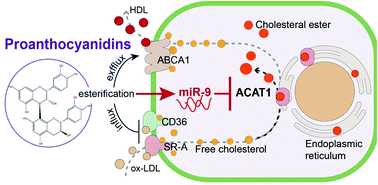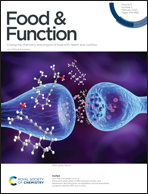Grape seed proanthocyanidins suppressed macrophage foam cell formation by miRNA-9 via targeting ACAT1 in THP-1 cells†
Abstract
Abnormal lipid metabolism in macrophages leads to atherosclerosis (AS). Excessive LDL cholesterol uptake by macrophages in the aortic endothelium leads to formation of foam cells. Previous studies suggested that proanthocyanidins effectively suppress this process, while the in-depth mechanism has not been elucidated. In mononuclear THP-1 cells, we found that the oligomeric fraction of proanthocyanidins was more effective in suppressing foam cell formation and 25 μg ml−1 for 48 h were the optimum conditions. Under these model conditions, we investigated gene expression and for the first time reported expression of regulatory microRNA (miRNA). It was found that the proanthocyanidins restrained macrophage foaming mainly by lowering the expression levels of cholesterol influx-related receptors CD36 and SR-A, and promoting the expression of cholesterol efflux-related receptor ABCA1. Further, it was latest revealed that proanthocyanidins could notably inhibit the expression of ACAT1, a key gene for intracellular cholesterol esterification. Further investigation was performed on the expression of regulatory miRNAs (miR-134 for CD36, miR-134, miR-155 for SR-A, miR-155, let-7g for LOX-1, miR-9 for ACAT1, miR-27a, miR-19b, miR-10b and miR-33a for ABCA1). The relative expression of miR-9, a miRNA targeting ACAT1, was decreased after the treatment of proanthocyanidins. It was most likely that proanthocyanidins suppressed the expression of ACAT1 via up-regulating the expression of miR-9, thus lessening the intracellular lipid accumulation and eventually inhibiting macrophage foam cell formation. This assumption was further verified by use of miR-9 mimic and its inhibitor.

- This article is part of the themed collection: Food & Function Recent HOT articles


 Please wait while we load your content...
Please wait while we load your content...